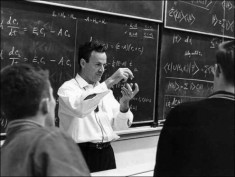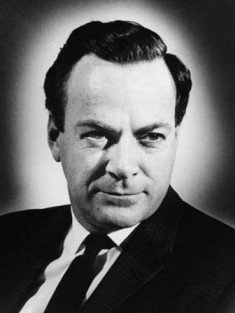Richard Feynman holds a place as one of the most influential physicists in popular culture. His work in areas related to quantum mechanics was truly revolutionary. In particular, his endeavors in areas of path integral formulation and quantum electrodynamics along with research in liquid helium definitely were far ahead of their time.
Feynman’s Early Days
Richard Feynman was born into a modest family in New York City. Although his family subscribed to Judaism, Feynman was not particularly religious. In fact, he became an atheist at a very young age. His father was very quick to instill in the young Feynman that it was critical to always question Orthodox beliefs.
Even as a child, Feynman had an interest in engineering. From this interest, he began to dabble in inventions and electronics. Before reaching his teens, he was able to create a home burglary system to make sure no one broke into the home when his parents were not there.
He would also invest an enormous amount of time teaching himself math. His aptitude was such that he was able to teach himself trigonometry, higher level algebra, geometry, and even calculus.
Formal Educational Years
Young Feynman would later allow his interest in engineering and electronics to prosper in the more structured environment of a formal education. In high school, he won the New York University Math Championship and did so with such high scores that none of the other competitors even came close to him.
Despite this accomplishment and his membership in the Arista Honor Society, Columbia University turned him down. Feynman was not deterred. He would go on and attend the Massachusetts Institute of Technology. A perfect score on his entrance exams led to acceptance into Princeton University’s graduate program.
The Manhattan Project
It was at Princeton that Robert R. Wilson, a physicist, suggested to Feynman that he take part in the ultra secret Manhattan Project in New Mexico. While Feynman was not one of the main scientists who worked on creating the atomic bomb, he did serve in a supportive capacity. Feynman found most of his work tedious and dull, but he was able to continue to learn more about higher levels of physics at the New Mexico facility where there project was undertaken.
Career Highlights
 In 1945, Feynman became a teacher at the University of Wisconsin–Madison. In time, he went to work at Cornell University and then to the California Institute of Technology (Caltech). No matter where he taught, he was known for his ability to explain even the most complex scientific things in layman’s terms. Feynman also had a fantastic sense of humor and this further helped endear him to students and peers.
In 1945, Feynman became a teacher at the University of Wisconsin–Madison. In time, he went to work at Cornell University and then to the California Institute of Technology (Caltech). No matter where he taught, he was known for his ability to explain even the most complex scientific things in layman’s terms. Feynman also had a fantastic sense of humor and this further helped endear him to students and peers.
Success at Caltech
It can be said some of Richard Feynman’s greatest achievements occurred during his tenure at Caltech. The work he performed in quantum electrodynamics was among his most well known accomplishment. In fact, he would go on and win the Nobel Prize for his achievements in this area.
The physicist, Lev D. Landau, had developed a theory about the physics related to the superfluidity of supercooled liquid helium. Feynman eventually was able to formulate a solid explanation backing the work of Landau. He worked on a model of weak decay and the model aided in illustrating couplings in vector and axial currents.
Also during his tenure at Caltech, he created what is known as a Feynman diagram. Such a diagram works as a bookkeeping system to aid in logging stats about particles in space time. The ability to ascertain the behavior of these subatomic particles was made possible thanks to these diagrams.
Legacy and Achievements
Feynman was an accomplished physicist. His greatest achievement may have been the Nobel Prize in Physics in 1965. He would also lend his expertise in the aftermath of the Space Shuttle Challenger disaster to determine what might have gone wrong. His early work in quantum computing led him to be considered one of the great innovators in the field. The entire concept of nanotechnology is credited to him. He continued to contribute greatly to the world of physics until his passing. Richard Feynman passed away in 1988 due to complications related to cancer.
